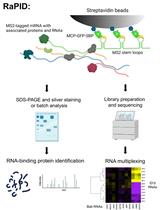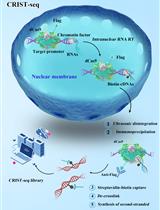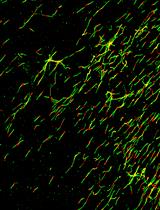- EN - English
- CN - 中文
Preparation of Yeast tRNA Sample for NMR Spectroscopy
酵母tRNA样品的核磁共振制备
发布: 2020年06月20日第10卷第12期 DOI: 10.21769/BioProtoc.3646 浏览次数: 4646
评审: Beatrice LiChristian RothLouise Jane Walport

相关实验方案

基于适体的 mRNA 亲和纯化程序 (RaPID) 用于鉴定酵母中的相关 RNA (RaPID-seq) 和蛋白质 (RaPID-MS)
Rohini R. Nair [...] Jeffrey E. Gerst
2022年01月05日 4748 阅读
Abstract
Transfer RNAs (tRNAs) are heavily decorated with post-transcriptional modifications during their biosynthesis. To fulfil their functions within cells, tRNAs undergo a tightly controlled biogenesis process leading to the formation of mature tRNAs. In addition, functions of tRNAs are often modulated by their modifications. Although the biological importance of post-transcriptional RNA modifications is widely appreciated, methods to directly detect their introduction during RNA biosynthesis are rare and do not easily provide information on the temporal nature of events. To obtain information on the tRNA maturation process, we have developed a methodology, using NMR as a tool to monitor tRNA maturation in a non-disruptive and continuous fashion in cellular extracts. By following the maturation of a model yeast tRNA with time-resolved NMR, we showed that modifications are introduced in a defined sequential order, and that the chronology is controlled by cross-talk between modification events. The implementation of this method requires the production for NMR spectroscopy of tRNA samples with different modification status, in order to identify the NMR signature of individual modifications. The production of tRNA samples for the analysis of modification pathways with NMR spectroscopy will be presented here and examplified on the yeast tRNAPhe, but can be extended to any other tRNA by changing the sequence of the construct. The protocol describes the production of unmodified tRNA samples by in vitro transcription, and the production of modified tRNA samples by recombinant expression of tRNAs in E. coli.
Keywords: Transfer RNA (转运RNA)Background
In all domains of life, the synthesis and maturation of RNAs involve post-transcriptional chemical modifications of their nucleotides at specific sites. Among the different RNA families, tRNAs display not only the highest variety of chemical modifications, but also the highest density of modification per transcript (~8-25% of modified nucleotides in tRNAs of various organisms) (Boccaletto et al., 2018). The biogenesis of tRNAs is tightly regulated, and in particular, the introduction of post-transcriptional modifications in tRNAs is controlled and influenced by multiple factors (El Yacoubi et al., 2012; Jackman and Alfonzo, 2013; Barraud and Tisné, 2019). Although all aspects of tRNA biology are controlled and modulated by modifications, methods to directly detect their introduction during tRNA biosynthesis are rare and do not easily provide information on the temporality of modification events. We have developed a methodology, using NMR as a tool to monitor tRNA maturation in a non-disruptive and continuous fashion (Barraud et al., 2019). Briefly, introducing isotope-labeled tRNAs into unlabeled cell extracts containing the cellular enzymatic activities combined with the use of isotope-filters in NMR experiments enables the detection of the tRNA of interest within the complex cell extract environment. This method requires the production of tRNA samples with different modification status, in order to identify the NMR signature of individual modifications (Barraud et al., 2019).
Here we describe the production and purification of two forms of the yeast tRNAPhe differing in their modification content. The first sample corresponds to a yeast tRNAPhe produced by in vitro transcription, which presents no post-transcriptional modifications. The second sample corresponds to a recombinant yeast tRNAPhe produced in an E. coli strain overproducing this tRNA. Since E. coli has a less prolific but related tRNA modification machinery than S. cerevisiae, the modification pattern of this sample resembles that of the fully modified yeast tRNAPhe, but overall exhibits fewer modifications (Barraud et al., 2019). The production and purification of tRNA samples with different modification content is essential to reveal the NMR signature of individual post-transcriptional modifications and correspond to the first steps towards the time-resolved NMR monitoring of tRNA maturation (Barraud et al., 2019). The reported protocol describes the production of unmodified tRNA samples by in vitro transcription, and the production of modified tRNA samples by recombinant expression of tRNAs in E. coli. These productions and purifications will be examplified on the yeast tRNAPhe. Part of the protocol has been published elsewhere (Barraud et al., 2019), but some parts are described here in more detail. Protocol for the expression and purification of active T7 RNA polymerase in E. coli are not detailed here, but have been described comprehensively elsewhere (Rio, 2013; Dégut et al., 2016).
Materials and Reagents
- Production of unmodified yeast tRNAPhe by in vitro transcription
For tRNA in vitro transcription- Commercial or in-house produced T7 RNA polymerase (stock stored at -20 °C at 1 mg/ml in 20 mM Na-phosphate pH 7.7, 100 mM NaCl, 10 mM DTT, 1 mM EDTA, 50% (v/v) glycerol).
- RNase-free water (double-distilled or MilliQ water 18.2 MΩ)
- Ready to use ATP, UTP, GTP, CTP at 100 mM in water at pH 8.0 (Jena Bioscience, catalog number: NU-1014L )
- Ready to use 15N-labeled UTP and GTP at 100 mM in water at pH 7.8 (Eurisotop, catalog numbers: NLM-4270-CA , NLM-4268-CA)
- DNA template
5′ TGGTGCGAATTCTGTGGATCGAACACAGGACCTCCAGATCTTCAGTCTGGCGCTCTCCCAACTGAGCTAAATCCGCTATAGTGAGTCGTATTA 3′ (Eurogentec, 1 μmol of synthesis scale, PAGE purification) - T7 promotor primer: 5′ TAATACGACTCACTATAG 3′ (Eurogentec, 0.2 μmol of synthesis scale, desalted)
- 280 mM MgCl2 (prepared in water) (CAS Number 7791-18-6)
- 80 mM GMP (prepared in water at pH 7.5, pH adjusted with concentrated HCl) (Sigma-Aldrich, catalog number: G8377-56 )
- 0.5 M Ethylenediaminetetraacetic acid (EDTA) (prepared in water at pH 8.0, pH adjusted with concentrated NaOH) (CAS Number 60-00-4)
- 0.1 M Spermidine (Sigma-Aldrich, catalog number: 0 5292 )
- 1 M 1,4-Dithiothreitol (DTT) (Sigma-Aldrich, catalog number: 43816 )
- TritonTM X-100 solution (Sigma-Aldrich, catalog number: T9284 )
- 20x T7 transcription buffer (TB) (see Recipes)
- Urea (Euromedex, catalog number: EU0014-B )
- 40% acrylamide/bis-acrylamide (19:1) solution (Euromedex, catalog number: EU0076-B )
- Ammonium persulfate (APS) (Euromedex, catalog number: EU0009-B ) prepared as 10% (w/v) solution in water
- N,N,N’,N’-Tetramethylethylenediamine (TEMED) (Euromedex, catalog number: 50406 )
- Bromophenol blue (Sigma-Aldrich, catalog number: B0126 )
- Xylene cyanol (Sigma-Aldrich, catalog number: X4126 )
- Toluidine blue (CAS Number 92-31-9, Sigma-Aldrich, catalog number: 198161 )
- Ethanol absolute (CAS Number 64-17-5, Millipore/Merck, catalog number: 1070172511 )
- 10x TBE buffer (Sigma-Aldrich, catalog number: T4415-1L )
- 2x RNA loading dye (see Recipes)
- Toluidine-blue staining solution (see Recipes)
For tRNA transcript purification and NMR sample preparation- Sterile syringe filters 0.22 μm (VWR, catalog number: 514-0073 )
- Dialysis sacks Spectra/Por 3 Dialysis Tubing MWCO < 3.5 kDa (Spectra/Por, catalog number: 132724)
- Standard Closures for Dialysis Tubing (Spectrum®, catalog number: 132735)
- Concentrators Amicon® Ultra-15 3,000 MWCO (Millipore/Merck, catalog number: UFC900308 )
- NaH2PO4 and Na2HPO4·12H2O (CAS Numbers 7558-80-7 and 10039-32-4, Sigma-Aldrich, catalog numbers: S3139 and 71649 )
- UltraPureTM 5 M NaCl (e.g., Thermo Fisher Scientific, catalog number: 24740011 )
- 1 M MgSO4 (prepared in water) (CAS Number 7487-88-9)
- 1 M MgCl2 (prepared in water) (CAS Number 7791-18-6)
- Purification buffer A (see Recipes)
- Purification buffer B (see Recipes)
- NMR buffer (see Recipes)
- Commercial or in-house produced T7 RNA polymerase (stock stored at -20 °C at 1 mg/ml in 20 mM Na-phosphate pH 7.7, 100 mM NaCl, 10 mM DTT, 1 mM EDTA, 50% (v/v) glycerol).
- Production of modified yeast tRNAPhe by in vivo recombinant expression in E. coli
For modified yeast tRNAPhe in vivo expression and extraction- Gene Pulser®/MicroPulserTM Electroporation Cuvettes 0.2 cm gap (Bio-Rad, catalog number: 1652082 )
- 50 ml conical tube (e.g., FalconTM, product number: 352070)
- Electrocompetent bacteria Escherichia coli JM101Tr strain (Mechulam et al., 1987)
Note: Alternatively, Escherichia coli JM101 or JM109 strains may also be used. - pBSTNAV plasmid (Addgene, catalog number: 45801 ) previously cloned with the yeast tRNAPhe DNA gene sequence (see Note 1 and Figure 3)
- Lysogeny Broth (LB) medium Gibco® (Thermo Fisher Scientific, catalog number: 10855021 )
- SPECTRA 9 medium (15N, 98%) (Eurisotop, catalog number: CGM-3030-N-1 )
- Celtone® Base Powder (15N, 98%+) (Eurisotop, catalog number: CGM-1030P-N-0.5 )
- Ampicillin, Ready Made Solution, 100 mg/ml, 0.2 μm filtered (Sigma-Aldrich, catalog number: A5354-10ML )
- Water-Saturated Phenol, pH 6.6 (Thermo Fisher Scientific, catalog number: AM9710 )
- Ethanol absolute (e.g., Merck, catalog number: 1070172511 )
- UltraPureTM 5 M NaCl (e.g., Thermo Fisher Scientific, catalog number: 24740011 )
- 1 M NaCl solution (e.g., FisherScientific, catalog number: S25877 )
- 2 M Tris-HCl pH 8.0
- 1 M Magnesium acetate (Sigma-Aldrich, catalog number: 63052 )
- RNase-free water (double-distilled or MilliQ water 18.2 MΩ)
- Extraction buffer (see Recipes)
For modified yeast tRNAPhe purification and NMR sample preparation- Microtubes 0.2 ml
- Dialysis sacks Spectra/Por 3 Dialysis Tubing MWCO < 3.5 kDa (Spectra/Por, product number: 132724)
- Standard Closures for Dialysis Tubing (Spectrum®, product number: 132735)
- Concentrators Amicon® Ultra-15 3,000 MWCO (Millipore/Merck, catalog number: UFC900308 )
- HiLoad 26/600 Superdex 75 pg column (GE Healthcare, catalog number: 28989334 )
- Mono Q 10/100 GL column (GE Healthcare, catalog number: 17516701 )
- Phenyl superose HR 10/10 column (GE Healthcare)
Note: Alternatively, a HiPrep 16/10 Phenyl HP column (GE Healthcare, catalog number: 29018184 ). - HiPrep 26/10 Desalting column (GE Healthcare, catalog number: 17508701 )
- 0.5 M NaOH solution (Fisher Scientific, catalog number: 15614900 )
- RNase-free water (double-distilled or MilliQ water 18.2 MΩ)
- Ammonium sulfate powder (Fisher Scientific, catalog number: 10325410 )
- 40% acrylamide/bis-acrylamide (19:1) solution (Euromedex, catalog number: EU0076-B )
- 1 M Tris-HCl pH 6.8
- 1 M Tris-HCl pH 8.8
- 20% (w/v) Sodium dodecyl sulfate solution (SDS) (Sigma-Aldrich, catalog number: 05030-1L-F )
- Ammonium persulfate (APS) (Euromedex, catalog number: EU0009-B ) prepared at 10% (w/v) solution in water
- N,N,N’,N’-Tetramethylethylenediamine (TEMED) (Euromedex, catalog number: 50406 )
- Tris-Glycine-SDS Buffer 10x Concentrate (TGS) (Sigma-Aldrich, catalog number: T7777 )
- 2-mercaptoethanol (CAS Number 60-24-2, Sigma-Aldrich, catalog number: M3148 )
- Glycerol (CAS Number 56-81-5, Sigma-Aldrich, catalog number: G5516 )
- Complementary DNA oligonucleotide at 100 µM in water 5′ TCGAACACAGGACCTCCAGATCTTCAGTCTGGCGCTCT 3′ (Eurogentec, 0.2 μmol of synthesis scale, desalted)
- 2x Laemmli loading buffer (see Recipes)
- Toluidine-blue staining solution (see Recipes)
- Purification buffer C (see Recipes)
- Purification buffer D (see Recipes)
- Purification buffer E (see Recipes)
- NMR buffer (see Recipes)
- Gene Pulser®/MicroPulserTM Electroporation Cuvettes 0.2 cm gap (Bio-Rad, catalog number: 1652082 )
Equipment
- Production of unmodified yeast tRNAPhe by in vitro transcription
For tRNA in vitro transcription- Water Bath
For transcription analysis by denaturing Urea-PAGE- Electrophoresis chamber, glass slides, spacers, clamps and combs for vertical PAGE (e.g., Bio-Rad Mini-PROTEAN), power supply (e.g., Bio-Rad PowerPac)
For tRNA transcript purification and NMR sample preparation- ÄKTA Purifier (GE Healthcare) or similar chromatographic system
- MonoQ 10/100 GL column (GE Healthcare, catalog number: 17516701 )
- Centrifuge (e.g., Beckman Coulter, model: Allegra X-30R )
- NanoDropTM spectrophotometer (Thermo Fisher Scientific, catalog number: ND-2000 )
- Production of modified yeast tRNAPhe by in vivo recombinant expression in E. coli
For modified yeast tRNAPhe in vivo expression and extraction- 2 L Erlenmeyer flasks (e.g., Fisher BrandTM, Fisher Scientific, catalog number: 15459103 )
- Incubation shaker (e.g., INFORS-HT Minitron)
- MicroPulserTM Electroporator (Bio-Rad, catalog number: 1652100 )
- Centrifuge for culture liters (e.g., Beckman Coulter, model: Avanti® J-E )
- Tube rotator (Thermo Fisher Scientific, catalog number: 88881002 )
- Vortex mixer (e.g., Scientific Industries SITM, model: Vortex-GenieTM 2, catalog number: SI-0236 )
For modified yeast tRNAPhe purification and NMR sample preparation- ÄKTA Purifier (GE Healthcare) or similar chromatographic system
- Sample loop 5 ml (GE Healthcare, catalog number: 18114053 )
- Superloop 10 ml and 50 ml (ÄKTA design) (GE Healthcare, catalog numbers: 18111381 and 18111382 )
- Electrophoresis chamber, glass slides, spacers, clamps and combs for vertical PAGE (e.g., Bio-Rad Mini-PROTEAN), power supply (e.g., Bio-Rad PowerPac)
- Dry bath incubator (Thermo Fisher Scientific, catalog number: 88870004 )
- Centrifuge (e.g., Beckman Coulter, model: Allegra X-30R )
- NanoDropTM spectrophotometer (Thermo Fisher Scientific, catalog number: ND-2000 )
- 2 L Erlenmeyer flasks (e.g., Fisher BrandTM, Fisher Scientific, catalog number: 15459103 )
Procedure
文章信息
版权信息
© 2020 The Authors; exclusive licensee Bio-protocol LLC.
如何引用
Catala, M., Gato, A., Tisné, C. and Barraud, P. (2020). Preparation of Yeast tRNA Sample for NMR Spectroscopy. Bio-protocol 10(12): e3646. DOI: 10.21769/BioProtoc.3646.
分类
生物物理学 > 核磁共振波谱法 > 体内NMR光谱法
生物化学 > RNA > RNA结构
分子生物学 > RNA > RNA 纯化 > 亲和纯化
您对这篇实验方法有问题吗?
在此处发布您的问题,我们将邀请本文作者来回答。同时,我们会将您的问题发布到Bio-protocol Exchange,以便寻求社区成员的帮助。
提问指南
+ 问题描述
写下详细的问题描述,包括所有有助于他人回答您问题的信息(例如实验过程、条件和相关图像等)。
Share
Bluesky
X
Copy link











